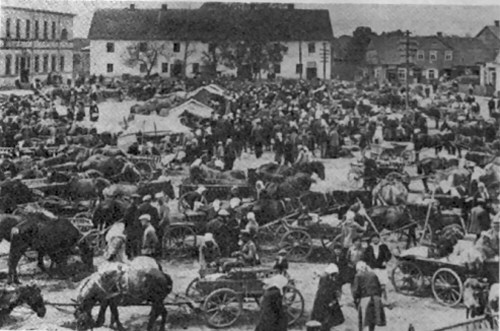The market in Rietavas before WW2

From the book
"Teach us to count our days" by Nahman (Natan) Katz
(see family tree of Rochel-Tilla Katz),
an account of his experiences as a partisan during the holocaust
Jews trace their origins in LITHUANIA to the 14th Century. By the late 15th century, there were several communities. Vilnius became known as the "Jerusalem of Lithuania". It was a great center of Jewish religious learning. The Jews of Lithuania had a great influence in the major Jewish political and cultural movements. On the eve of the Holocaust, there were about 220,000 Jews in Lithuania and the surrounding area including refugees from German-occupied Poland. During the German occupation, about 95% of Lithuanian Jews were killed by the Nazi's and by ethnic Lithuanians.
WILKOMIR
(In Lithuanian "Ukmerge"/"Ukmrgay")
a town in Lithuania, USSR.
The town is first mentioned in 1685. Most of the population were merchants and tradesmen. When the Russians took over the country
in 1910, the economy deteriorated, and the number of Jews living there decreased. In 1915, the Jews were expelled. Few returned after the war.
In Independent Lithuania (1918-1940)the community established two schools and a yeshiva in Hebrew and Yiddish. When Lithuania was annexed to the USSR in 1940, Jewish institutions were closed down and community activities were prohibited.
IN SEPTEMBER 1941, THE JEWS OF WILKOMIR AND SURROUNDINGS WERE TAKEN OUT TO A NEARBY FOREST AND MURDERED.
RIETEVEH (RIETAVAS)
Rieteveh was apparently the first town
in Lithuania to have electricity, thanks to a progressive Polish baron, Oginski. He employed the entire "shtetl" to work in his lumber business and to harvest his flax to make linen.
At the beginning of the 20th century, the population of Rietavas numbered 5,000, one fifth being Jewish.
Rietavas boasted a Jewish library, sports organization Bar Kochba and Maccabee, a cheder for boys, a school for girls, a secular gymnasium, a yeshiva, an agricultural school and a theatre group. There was also a court of law (two Jewish attorneys lived in the town)and a volunteer fire department consisting mostly of Jewish volunteers.
During WW2, in about 1942, the Lithuanian Nazi collaborators took all the remaining Jews in Rietavas, marched them 35 km to Telshai and threw them into mass graves.
Rocha-Tilla Katz (nee Awerbach) my grandfather Zemach's sister, was taken on a forced march in 1941 along with other Jewish women and murdered in a nearby forest.
DVINSK (DAUGAVPILS/DUENABURG)
Dvinsk (Daugavpils) lies on the Western Dvina (Daugava) river; It was a fortified city for several years. In 1805 the Jews formed the majority of the population. The town developed extensively from the 1860's and Jews played a prominent part in the city's commerce and industry. Dvinsk became a center of activities of the Jewish workers' movements. During the 1905 revolution, 30 people, mostly Jews, were killed or wounded in demonstrations. Dvinsk was known as a center of Torah learning, and had a number of Yeshivot.During World War I the city was severely damaged and was abandoned by most of its inhabitants.
When the Germans occupied Daugavpils at the end of June 1941, the Nazis organized a POGROM on the Jews of the city. Synagogues were burned down or taken over by the army. A GHETTO was set up in July 1941 including Jews from the surrounding localities.
IN OCTOBER 1941, MOST OF THE JEWS IN THE GHETTO WERE MURDERED. THE GHETTO WAS LIQUIDATED IN MAY 1942.
BACK to GENEALOGY HOMEPAGE